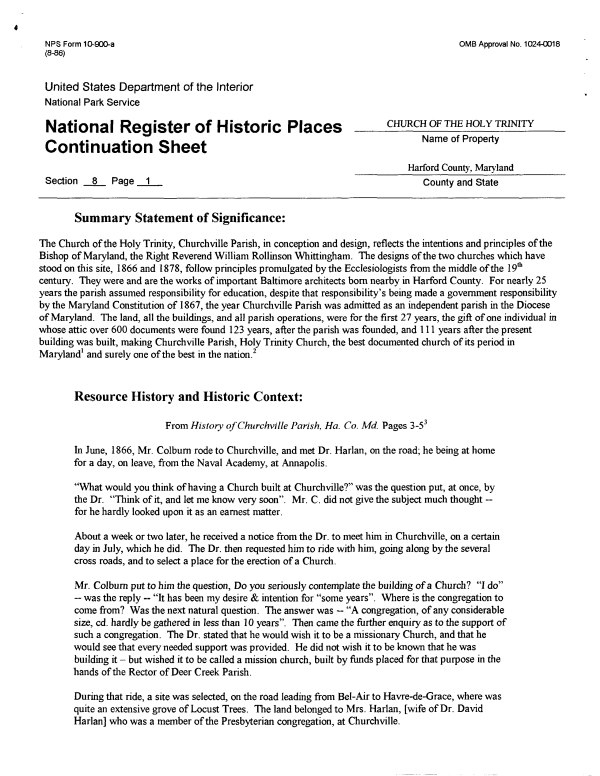 |
||||
|
DEPARTMENT OF HOUSING AND COMMUNITY DEVELOPMENT, MARYLAND HISTORICAL TRUST (Historic Sites Survey) var.d. MSA SE16-8 Image No: se16-8-0355 Enlarge and print image (69K) |
 |
||||
|
DEPARTMENT OF HOUSING AND COMMUNITY DEVELOPMENT, MARYLAND HISTORICAL TRUST (Historic Sites Survey) var.d. MSA SE16-8 Image No: se16-8-0355 Enlarge and print image (69K) |
| NFS Form 1O-900-a OMB Approval No. 1024-0018 (8-86) United States Department of the Interior National Park Service National Register Of Historic Places CHURCH OF THE HOLY TRINITY -^ A. .. f^. < Name of Property Continuation Sheet Harford County, Maryland Section 8 Page_!_ County and State Summary Statement of Significance: The Church of the Holy Trinity, Churchville Parish, in conception and design, reflects the intentions and principles of the Bishop of Maryland, the Right Reverend William Rollinson Whittingham. The designs of the two churches which have stood on this site, 1866 and 1878, follow principles promulgated by the Ecclesiologists from the middle of the 19th century. They were and are the works of important Baltimore architects born nearby in Harford County. For nearly 25 years the parish assumed responsibility for education, despite that responsibility's being made a government responsibility by the Maryland Constitution of 1867, the year Churchville Parish was admitted as an independent parish in the Diocese of Maryland. The land, all the buildings, and all parish operations, were for the first 27 years, the gift of one individual in whose attic over 600 documents were found 123 years, after the parish was founded, and 111 years after the present building was built, making Churchville Parish, Holy Trinity Church, the best documented church of its period in Maryland1 and surely one of the best in the nation.2 Resource History and Historic Context: From History of Churchville Parish, Ha. Co. Md. Pages 3-53 In June, 1866, Mr. Colburn rode to Churchville, and met Dr. Harlan, on the road; he being at home for a day, on leave, from the Naval Academy, at Annapolis. "What would you think of having a Church built at Churchville?" was the question put, at once, by the Dr. "Think of it, and let me know very soon". Mr. C. did not give the subject much thought — for he hardly looked upon it as an earnest matter. About a week or two later, he received a notice from the Dr. to meet him in Churchville, on a certain day in July, which he did. The Dr. then requested him to ride with him, going along by the several cross roads, and to select a place for the erection of a Church. Mr. Colbum put to him the question, Do you seriously contemplate the building of a Church? "I do" — was the reply — "It has been my desire & intention for "some years". Where is the congregation to come from? Was the next natural question. The answer was — "A congregation, of any considerable size, cd. hardly be gathered in less than 10 years". Then came the further enquiry as to the support of such a congregation. The Dr. stated that he would wish it to be a missionary Church, and that he would see that every needed support was provided. He did not wish it to be known that he was building it - but wished it to be called a mission church, built by funds placed for that purpose in the hands of the Rector of Deer Creek Parish. During that ride, a site was selected, on the road leading from Bel-Air to Havre-de-Grace, where was quite an extensive grove of Locust Trees. The land belonged to Mrs. Harlan, [wife of Dr. David Harlan] who was a member of the Presbyterian congregation, at Churchville. |